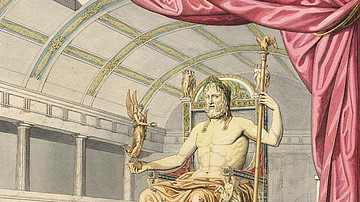Search Images
Browse Content (p. 1394)

Image
Arjuna Wins Draupadi
Arjuna wins the hand of Draupadi after defeating his other Pandavas brothers in a competition set up by her father, the king of Drupada. Arjuna won by hitting the eye of the rotating fish in the sky. (c. 1885 CE watercolour, Victoria & Albert...

Image
Pandavas
According to some intepretations this temple relief sculpture represents the five Pandavas of Hindu mythology and Draupadi, one of their wives. The heroes of the epic Mahabharata are here shown (left to right): Bhima, Arjuna, Yudisthira...

Image
Bronze Statue of Neith
A gilded bronze statuette of the Egyptian goddess of war Neith. 664-332 BCE.
Louvre Museum, Paris.

Image
Aegis of Neith
Aegis of Neith, the Egyptian goddess of war. Gilded bronze, XXVI Dynasty, c. 664-525 BCE. (Museum of Fine Arts, Lyon)

Image
Epona
A stone statue representing the Celtic goddess Epona with two horses, an animal she was often associated with. 200 CE. (Historic Museum of Bern)

Image
Model of the Mausoleum at Halicarnassus
A modern scale model of what the 4th century BCE Mausoleum at Halicarnassus may have looked like, one of the Seven Wonders of the world. (Miniatuk, Istanbul)

Image
Alexandrian Coins Depicting the Lighthouse of Alexandria
Two coins depicting the Lighthouse of Alexandria, one of the Seven Wonders of the World. Alexandrian mint, 2nd century CE.

Image
Statue of Zeus at Olympia on a Coin of Hadrian
A coin from the reign of Hadrian depicting the staute of Zeus at Olympia, on of the Seven Wonders of the World. 117-138 CE. (National Archaeological Museum, Florence)

Image
Statue of Zeus, Olympia
An 19th century CE illustration of what the 5th century BCE statue of Zeus at Olympia, one of the Seven Wonders of the World, may have looked like.

Image
Amun
Ram-headed Amun-Ra from ancient Egypt.
Ashmolean Museum, Oxford.